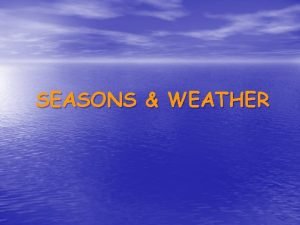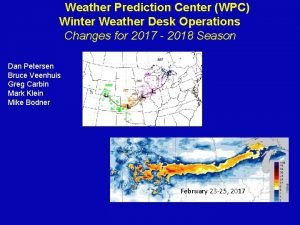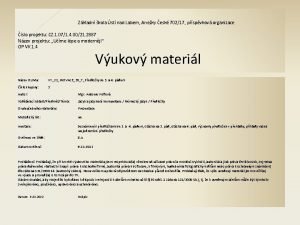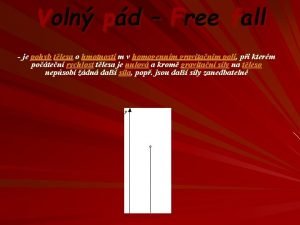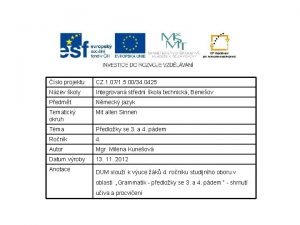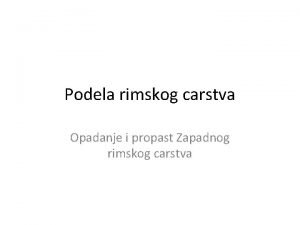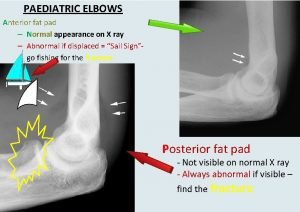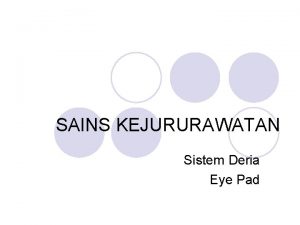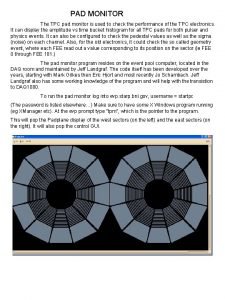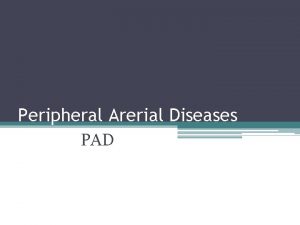PAD 3 O WINTER SURVIVAL REVIEW Winter Weather
































- Slides: 32

PAD 3 O WINTER SURVIVAL REVIEW

Winter Weather Winter Storm Watch: Sever conditions, heavy snow and/or ice are possible within the next day. Winter Storm Advisory : Conditions are expected to cause significant inconveniences and may be hazardous. EXERCISE CAUTION DRIVING!!!

Winter Weather Winter Storm Warning: Sever conditions have begun or are about to in your area. STAY INDOORS Blizzard Warning: Snow and strong winds will combine to produce blowing snow with near zero visibility, deep drifts, and life-threatening wind chill SEEK SHELTER IMMEDIATELY

Winter Precipitation (3) types 1) Snow Flurries: light snow falling for durations, resulting in light accumulation Showers: snow falling at varying intensities for brief periods. Some accumulation is possible Blowing Snow: wind driven snow that reduces visibility and causes drifting Blizzard: winds of more than 80 km/h with snow and blowing snow making visibility near zero. Lake Effect: snow that is not falling but forms moisture in the air above nearby lakes that causes drifting.

Winter Precipitation (3) types 2) Sleet Forms from rain drops that freeze into ice pellets before reaching the ground. Bounces when hits surface Makes driving treacherous

Winter Precipitation (3) types 3) Freezing Rain Falls onto a surface with a temperature below freezing Causes it to freeze to surfaces such as trees, cars , roads, and form a coating of ice. Extremely hazardous driving conditions

Hypothermia A condition in which the core of the body is losing heat faster than it is produced.

Hypothermia - Symptoms Mechanisms of heat lose 1) Conduction – Heat lose from direct contact between a warm body and a cold one. (ie. Sitting on the snow_ 2) Convection – heat lose to moving air and or water (ie the wind strips heat from you (wind chill) 3) Evaporation – hear lost through the evaporation of water from skin and also inhale cold air and exhaling warm air.

Hypothermia – Symptoms Heat Production 1) Metabolism – using food to produce energy through cellular respiration 2) Exercise – generate body heat, “an active camper is a happy camper” 3) Shivering – produces heat; body’s way of telling us to warm up.

Hypothermia – Prevention Be aware of wind chill Drink plenty of warm fluids Avoid alcohol Stay active to maintain body heat Wear rain gear or wool; wool will insulate you even when it is wet Have high energy foods (contain lots of sugar like chocolate bars); sugar stimulates shivering which is the bodies way of re-warming itself.

Hypothermia - treatment Warm the body slowly Warm the bodies core first; if needed, use your own body heat to help. Warming the extremities first may drive the cold toward the heart and could lead to heart failure. Get the victim into dry clothing and wrap them in blanket ***head and neck*** Give the victim warm and sweet foods and drinks Can put victim in sleeping bag with others to warm them up.

Frost Bite Cold related injury characterized by the freezing of tissue. Cold exposure lead to ice crystal formation, cellular dehydration, and abnormal cell wall permeability Causes a loss of feeling and a white or pale appearance in the extremities such as fingers, toes, ear lobes or the tip of the nose.

Frost Bite – Symptoms Stinging, firmness, numbness, clumsiness, throbbing, joint pain, excessive sweating. 1 st degree - waxy appearance, white plaques, sensory deficit 2 nd degree – clear blisters 3 rd degree – blood filled blisters 4 th degree – damage affecting muscles, tendons and bones.

Frost Bite - Prevention Wear several layers of clothing and a hat (toque) Limit use of alcohol (causes blood to cool too quickly) and tobacco (inhibits circulation ) Avoid unnecessary exposure of any part of the body Take frequent breaks from the cold temperature.

Frost Bite - Treatment Bring victim indoors asap Try not to disturb any blisters Apply warm towels or immerse the area in luke warm water for twenty minutes Do not apply hot water or use direct heat, fire or a heating pad Do not rub the area in any way Re-warming will be accomplished by a burning sensation

Frost Bite - Treatment Skin may blister and swell; may turn red, blue, purple When the area is pink and no longer numb, the area is thawed Large blisters will develop and need to be protected from breaking open (infection) Wrap re-warmed areas to prevent refreezing

Dressing in Layers Why dress warm To prevent cold injuries (hypothermia, frost bite, etc) To enjoy outdoor activities (hunting, fishing, snowboarding, skiing, etc) To provide a balance between your body temperature, your clothing and weather.

Dressing in Layers Dressing in layers doesn’t mean that the more clothes you wear the warmer you’ll be. As you exercise you burn calories, generate body heat and sweat as your body tries to cool its self off. Dressing in layers will keep your skin dry and prevent chilling when sweat evaporates.

Dressing in Layers 1 st Layer (Base layer) Lightweight synthetic or silk or nylon polyester-spandex tights, under amour This will pull sweat away from your body Lets water vapour escape Cotton is not a good choice as it gets wet when you sweat

Dressing in Layers 2 nd Layer (insulation) Should provide insulation to retain body heat. Made of breathable fabrics that provide warmth even when wet Good choices are polar fleece or wool Create dead air space that your body can warm up.

Dressing in Layers 3 rd Layer (Shell) Final layer should be breathable, wind and water resistant Should be large enough to permit sufficient layering underneath and allow for unhindered movement. Down filled jackets or thinsulate materials are good choices Functions as a wind break

Dressing in Layers Extremities Wear a wool hat to prevent heat loos from your head (most heat lost hear) Wool or synthetic socks (smartwool) and gloves (thinsulate) will also protect cold sensitive hands and feet.

Quinzhees The smaller the quinzhee, the stronger it will be. (6 feet in diameter for 3 people, + 1 foot for each additional person The more you disturb the snow, the stronger it will be.

Quinzhee – Steps 1. Make a circle by a shovel or by trampling the snow 2. Throw snow into the circle, about 4 -6 feet high. DO NOT DIG THE BOOT PATH 3. As you throw snow, pack it, and wack it so it becomes very hard 4. Find some sticks and pin cushion the hut about 12 -16” in (This will help you when you dig the center )

Quinzhee - Steps 5. Make a door (away from the wind) by digging down until you are about 5” from the ground and then into the hut 6. Arch out the ceiling until you reach the sticks, light will start to come through the snow at about 16”, this is your clue to STOP digging. 7. Make small holes for ventilation

Quinzhees – Things to remember The digger is called the MOLE Always have someone at the door to remove the snow the MOLE digs Don’t let the door fall in Make sure to dig the roof and the sides, do not leave the roof too full! It will cave in. ! To trap heat, make a sleeping platform.

Ice Conditions Ice Colour Ice conditions are based on ice that is either: �Clear �Blue �Green White Ice has snow or air trapped in in

Minimum Ice Thickness Stay Off the Ice 3” or less Ice Fishing, walking, cross country skiing 4” One Snow machine or ATV 5” One car or small truck 8 – 12” One truck or van 12 -15”

Ice first forms and melts near the shore Spring ice is rotten ice.

Ice Safety – If someone falls through the Ice Call 911 Lay down on the ice Use a long reach assist (rope, stick, ladder) Tell the person to kick and slowly ease out of the water 5. Have them roll or crawl from the broken ice 6. Make sure you are both far enough away from the hole before you stand up 7. Help them into ice and treat for hypothermia 1. 2. 3. 4.

Questions What areas do you lose body heat from? What are some types of winter precipitation What winter layers should a person wear Frost bite vs hypothermia Ways to avoid Treatment

Questions How do you build a quinzhee It is safe to……… on the ice when it is how thick? What to do if you fall in.
 State of survival survival of the fittest tweak
State of survival survival of the fittest tweak State of survival survival of the fittest stages
State of survival survival of the fittest stages Winter kommt winter kommt flocken fallen nieder
Winter kommt winter kommt flocken fallen nieder Winter kommt flocken fallen nieder
Winter kommt flocken fallen nieder Meine lieblingsjahreszeit ist der winter
Meine lieblingsjahreszeit ist der winter Spring summer autumn fall
Spring summer autumn fall Wpc probabilistic winter precipitation guidance
Wpc probabilistic winter precipitation guidance 2016-17 snow forecast
2016-17 snow forecast Weather symbols
Weather symbols Whether the weather be cold tongue twister
Whether the weather be cold tongue twister Her poem clothing
Her poem clothing It's sunny and windy
It's sunny and windy Whether the weather
Whether the weather Heavy weather by weather report
Heavy weather by weather report Capital weather gang weather wall
Capital weather gang weather wall Chapter review motion part a vocabulary review answer key
Chapter review motion part a vocabulary review answer key Ap gov final review
Ap gov final review Nader amin-salehi
Nader amin-salehi What is inclusion and exclusion
What is inclusion and exclusion Narrative review vs systematic review
Narrative review vs systematic review Předložky se 3 pádem němčina
Předložky se 3 pádem němčina Volný pád vzorec
Volný pád vzorec Maynooth student pad
Maynooth student pad Pad web
Pad web Volný pád vzorec
Volný pád vzorec Ambling pad
Ambling pad Components of diathermy machine
Components of diathermy machine Slidetodoc. com
Slidetodoc. com Předložky 3 pád němčina
Předložky 3 pád němčina Volný pád vzorec
Volný pád vzorec Rimsko carstvo podela
Rimsko carstvo podela Pad
Pad Pile foundation details
Pile foundation details





